Review of the submersible pump “Baby”: unit diagram, characteristics, operating rules
Many owners of country and private farms not connected to a centralized water supply are familiar firsthand with the problem of supplying water to their home and garden plot.
The “Malysh” submersible pump will help partially solve this problem; although it is not a powerful device capable of pumping water from artesian wells, it can cope with supplying water from wells, shallow wells and open reservoirs.
It will be useful for those who are just planning to set up an autonomous water supply, as well as users of pumping equipment, to learn about the structure, operating principle and operating rules of the unit. We will describe in detail how to install the “Baby” in a well and ensure its uninterrupted operation.
The content of the article:
Purpose of the deep vibrator
Submersible pumps of the “Malysh” series are produced by the Russian company Livgidromash, whose history goes back almost seventy years. During this time, more than three million units of various pumping equipment rolled off the plant's assembly line.
Despite the wide selection of submersible unitsthat the market offers today, many consumers choose the products of the Livensky plant.And it is no coincidence that “Malysh” pumps, thanks to their good technical characteristics, ease of use and low cost, withstand the competition with dignity.
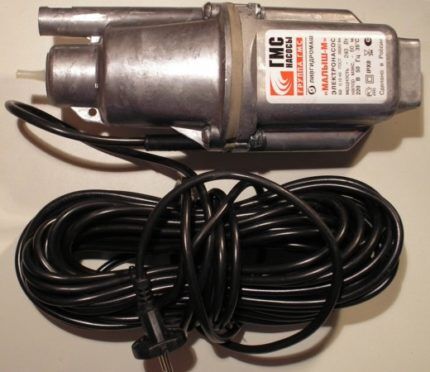
The device, small in size (up to 255 mm) and weight (up to 3.4 kg), will cope with a number of tasks with a bang.
It will provide:
- uninterrupted water supply from wells and wellshaving an internal diameter of 8 - 11 cm, as well as any reservoirs with a water temperature not higher than 35 degrees;
- pumping water from open sourceslocated at a distance of more than one hundred meters from the house or summer cottage;
- transportation of water from storage tanksand directly into the water supply system of the house;
- formation of water reserve for abundant watering of plants in the open ground or in a greenhouse, for maintaining the territory and other economic purposes;
- pumping water from basements during their flooding by flood waters;
- filling country pools and draining water;
- pumping dirty water from silted or just drilled water intake shaft.
It should be noted that “Kid” can work productively only if the amount of impurities of mechanical particles does not exceed 0.01%. When pumping water from heavily silted sources, as well as from rivers with a significant sand content, it is necessary to use a filtration system.
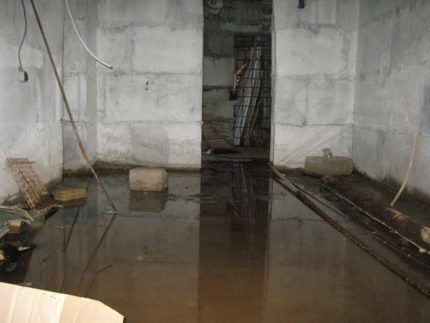
Overview of the pump range and their differences
There are three main models of submersible pumps, which have slight differences in technical parameters, as well as different (upper or lower) water intake systems, and therefore their scope of application is somewhat different.

Basic model: features and specifications
The classic Malysh pump is available with a lower water intake, thanks to which it:
- most efficiently supplies water from open reservoirs located over long distances,
- copes well with draining flooded lower floors and basements of buildings,
- can pump water to the lowest possible level.
At the same time, if the nozzles that suck in liquid are located at the bottom, sand particles may get inside the unit, which can cause damage to the device. Therefore, it is not recommended to use it in heavily polluted water bodies without installing special filters.
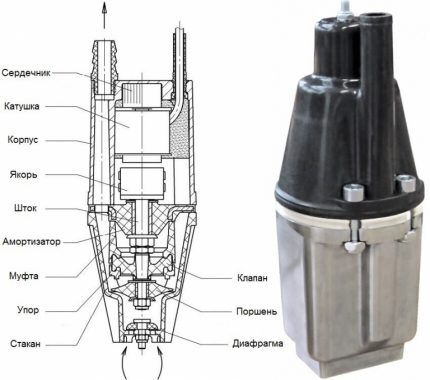
Pump with marked "K", in fact, is the same “Baby”, but with built-in additional thermal protection.
A thermal relay is installed in its case, which turns off the device if it overheats. The model is convenient in that the device can be left to work unattended for a sufficiently long period of time without worrying that it will burn out.
Device with marked "P" informs that its body is made of plastic; if there is no marking, then it is made of aluminum. It is worth noting that the aluminum case, although somewhat more expensive, is more durable and reliable.
There are often cases when the plastic case cannot withstand the load and cracks appear on it. Therefore, the desire to save money can lead to the opposite result, and you will have to buy a new device.
Other modifications of the “Baby” pump
Other models "Baby-M" And "Baby 3" differ from the classic pump in that it has an upper water intake. At the same time, if the first is identical in technical characteristics to the base model, then the second has significant differences. The parameters of all devices are shown below.
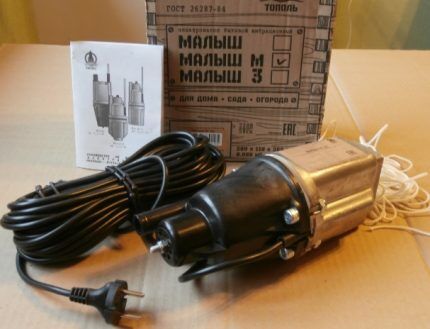
Units with an overhead suction pipe are usually used to supply water from wells and boreholes.
They can be used in places where pumps with bottom water intake are at risk of failure: in heavily polluted reservoirs, since during operation they do not lift particles of debris and silty deposits from the bottom that clog the system.
In models with an upper intake, the engine is cooled better, due to which the pump does not overheat.
Technical parameters of models
The pumps operate from a regular 220 V network and can be immersed to a depth of up to three meters. When working in low-yield wells (with a small volume of water), deeper lowering is possible.
The productivity of all models is 430 l/h, while "Baby" And "Baby-M" have a head of 40 m (maximum – 60 m), "Baby 3" – 20 m (maximum – 25 m). When working without pressure, productivity increases to 1500 liters.
The dimensions and power of the devices also have different indicators. Thus, the power of the basic model and modification with the letter “M” is 240 W, length – 25.5 cm, weight – 3.4 kg.
The power of the Malysh-3 pump is only 185 W, its length does not exceed 24 cm, and its weight is 2 kg, so it is usually used for drawing water from shallow wells and wells with an internal diameter of 8 cm.
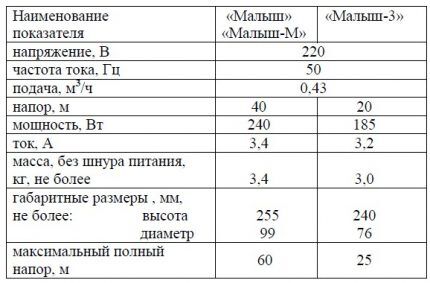
Another parameter that you should know when purchasing a device is electrical protection class. By default, all pumps that do not indicate this indicator have protection class 2.
The first class is designated by the Roman numeral I.At the same time, class 2 devices are equipped with reinforced insulation and are supplied with a cord with two cores. Class 1 devices are additionally equipped with a three-wire grounding cable.
Design and principle of operation of the pump
The design of the “Malysh” pump is quite simple; it consists of a durable sealed housing that prevents the ingress of liquid, inside of which there is an electric drive, including a core, two coils, an electrical wire, and a vibrator.
In the upper (for pumps with an upper water intake) or lower (for devices with a lower water intake) part of the housing there is a valve that closes the inlet holes and ensures the free outflow or inflow of water in the absence of pressure.
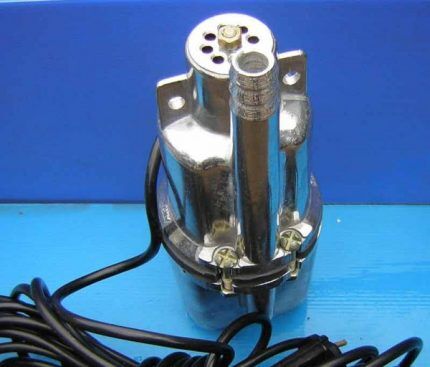
The operation of the pump is based on the use of alternating current force, which, under the influence of a shock absorber, activates the armature and piston, forcing them to perform mechanical oscillatory movements, while simultaneously pushing water into the pressure pipe.
Use and operating rules of the device
Before operating the Malysh pump, you must familiarize yourself with the rules for its safe operation. There are a number of restrictions under which it is strictly prohibited to use the device.
Rules for safe use:
- The device cannot be used with a damaged cord or at high voltage;
- when the pump is turned on, it is forbidden to shut off the water supply;
- the unit should operate no more than twelve hours a day;
- Continuous operation should be no more than two hours with periodic shutdowns for twenty minutes.
All restrictions are described in detail in the instructions for the device, which you must read in order to avoid unforeseen consequences.
The process of preparing the pump for operation
To work, you will need a flexible rubber or similar elastomeric hose with an internal diameter of at least 18 mm. It is not recommended to use smaller hoses as they create unnecessary stress on the device.
You can use plastic or metal pipes to supply water, but in any case they must be connected to the pump only through a hose with a minimum length of 2 m.

The hose is connected to the outlet pipe of the device using a clamp.If the vibration pump is intended to be used in winter, then to prevent freezing and ensure free flow of liquid, it is necessary to make a small 1.5 mm hole in the hose next to the body. In the summer, the hole can be covered with electrical tape.
Then a 10 m long nylon cord, which is included in the delivery set, is attached to the pump eyes. To increase the length, you can use wire by attaching it to a nylon cord.
However, you cannot attach a wire or metal cable directly to the submersible unit - this can cause damage to the mounting holes.
It is necessary to calculate in advance the distance from the outlet to the water source. This determines how long the cable will be needed to connect the vibration pump. The baby is equipped with a power cord with a length of 6-40 m, its exact length is indicated in the instructions.
Thus, three cords should come from the pump: an electrical wire, a rubber hose and a nylon cable. They must be connected to each other in several places with tape at intervals of 100-200 cm. Moreover, the first connection should be located no further than 20 cm from the device body.
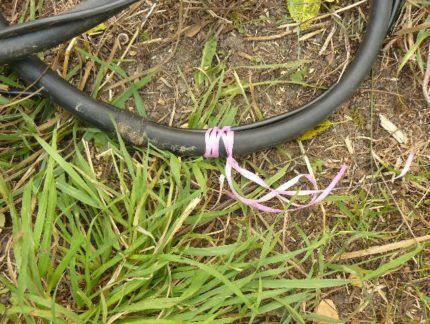
Specifics of installing the device in a well
The pump vibrates during operation. It is possible that it will come into contact with the walls of a casing pipe or a narrow well, which will inevitably lead to damage to the casing and equipment breakdown.
To avoid this, before install the pump and immerse the unit in water, you must put a rubber ring on it, which will absorb possible shocks and serve as additional protection for the housing.
The pump must be lowered into the water and positioned correctly; it must hang evenly, without touching the walls. A bar is installed on top of the well, to which a suspension made of durable elastic material is attached. The suspension is necessary to reduce vibration during operation of the device.
The material you can use is a piece of rubber hose or a medical tourniquet. The upper end of the cable is connected to the suspension, creating good tension. But for the electrical wire, excessive tension is absolutely not necessary; it should lie freely on the bar.
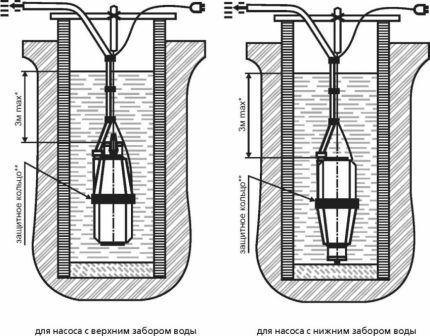
The new “Malysh” pump is completely ready for use; it does not need to be filled with water or lubricated before use. If the device you are using has 1 protection class, The socket must be grounded. The device can be turned on immediately after immersion in a well or pond.
The distance from the bottom to the housing for devices with bottom water intake must be at least one meter. A submersible pump with an upper suction port can be lowered much lower, but in any case its housing should not touch the bottom to avoid damage during operation.
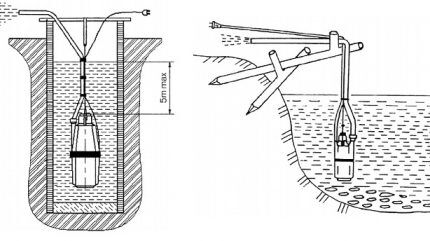
In the event that water is pumped from shallow reservoirs, as well as when pumping out flooded basements, the pump can be lowered to the bottom.The housing should first be wrapped in thick cloth or a sheet of rubber placed under the unit.
Ensuring smooth operation
In order for the “Baby” to work without interruption and for as long as possible, it is necessary to monitor the network voltage. In case of power surges, the device must be turned off immediately. Also need control the quality of pumped water, since a common cause of equipment failure is sand and debris getting into the mechanism.
Many people think that this problem can be solved by installing a pump with an upper water intake. However, clogging of the device often occurs not only due to bottom sediments entering it; dirty water can also cause breakdowns.
To protect the submersible pump, it is advisable to install a filter that traps the smallest particles and prevents them from penetrating inside the tank.A simple filter device can be do it yourself.
The use of a filter will not only extend the life of the unit, but will also ensure the supply of higher quality water, purified from any impurities.

Malysh pump maintenance
In order for the pump to serve for a long time and properly, it is necessary to comply with the operating and storage conditions recommended by the manufacturer. In this case, the manufacturer guarantees its normal operation for two years. The pump does not require complex maintenance and care, and simple rules are not difficult to follow.
After the first installation of the device in the well, you need to let it work for one or two hours, and then remove it and carefully inspect the body and components to detect any malfunctions. If everything is fine, then the vibration pump can be put back in place and used further, leaving it immersed in water for a long time.
Periodically, at least once every three months, and if possible, then every hundred hours of operation, the unit must also be inspected. If traces of friction are found on the housing, it means that it was installed incorrectly and during operation came into contact with the walls of the water intake excavation.
To avoid this, you need to set it level and put an additional rubber ring on the body.
If the inlet holes become clogged, they must be carefully cleaned without damaging the rubber valve. For cleaning, it is best to use a tool with a blunt end.
If the pump is not used in winter, it must be removed from the well, washed and dried thoroughly. During storage, the unit should be placed away from heating devices and also protected from direct sunlight.
If, while following the manufacturer's recommendations, a breakdown occurs for reasons beyond the user's control, the pump should be taken to a service center. A list of popular malfunctions of the “Baby” pump and ways to eliminate them are described in this article.
Conclusions and useful video on the topic
How to choose a submersible pump “Baby”, and what points to pay attention to when purchasing, you will learn from this video:
The following video explains how the pump can be improved:
How to perform preventive inspection and maintenance of the device can be found here:
The “Baby” submersible pump is a convenient and inexpensive household appliance, easy to use and easy to maintain. Of course, due to its small power, it is not capable of providing full water supply to a private home, and, in fact, no one sets such tasks for it.
The inexpensive vibrator is perfect for seasonal use. He will become a real assistant in summer cottages. Thus, with the help of “Kid” you can organize watering of plants and water supply from wells, wells or open reservoirs.
Do you have experience installing or using the Baby pump? Please share information with our readers, tell us about the specifics of the unit’s operation. You can leave comments and ask questions in the form below.




When I needed to buy a pump for my dacha, I chose between several models.The house has a bathroom and a sink for washing dishes, so a pump was needed that would supply water to the house and handle the irrigation. I took the Baby with an aluminum body - after all, I bought it for more than one year. The water in the well is not particularly clean, but the pump does not clog (if it runs for more than 2 hours in a row, I turn it off so as not to wear out the engine).
I have a well about 8 meters deep. Of course, we don’t drink this water, but it’s quite suitable for irrigation. I bought a well pump and couldn't be happier with it. It has been pumping water from the well perfectly for the 8th season now. There were no problems with its operation. Only once did one tension bolt come loose due to vibration, and no more problems. Oddly enough, it never gets clogged with fine soil suspension or any other debris. Very reliable pump, doesn't give me any headaches.
Why is the number of atmospheres at the outlet not indicated anywhere in the description? For me this is important, since the hose only works at a certain pressure...
Head 40m = 4 bar.
Can the pump be left in water for a long time?